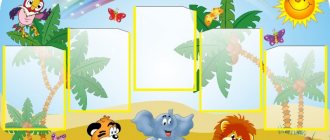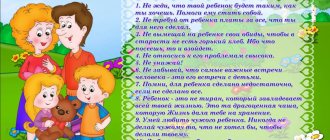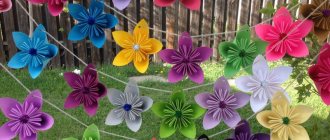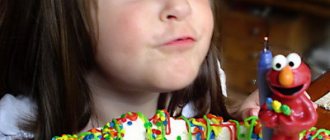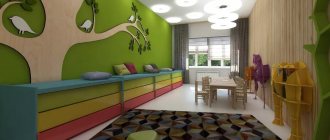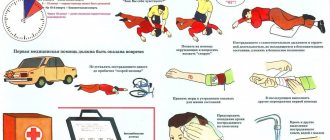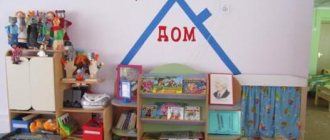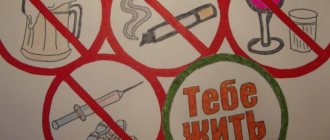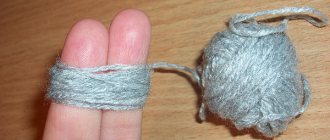Art Corner
To properly organize children's activities, zoning of space in the group room is provided. That is why you can find various themed corners such as “Kitchen”, “Hospital”, “School”, etc.
Some kindergarten teachers place the theater corner in a separate structure. However, more often we see large art centers where various subsystems are combined. They can combine a circle of drawing, music, manual labor and theater. This saves space. And most importantly, the basic principles of the theater corner are observed.
Requirements for a creative center
Since the theater corner in a kindergarten group is the most important element of the artistic and aesthetic development of children, it must comply with the following principles:
- The principle of mobility. It is necessary to provide for the possibility of combining different corners and zones of the kindergarten group, as well as the transportability of theater paraphernalia.
- The principle of material replacement. It is necessary to constantly update the repertoire, scripts, scenery and other paraphernalia. This will depend on many factors, for example, the time of year, the age of the children, their interest, software, topics of classes, etc.
- The principle of multifunctionality. It implies that the same attribute can perform multiple tasks.
- The principle of aesthetics. Theater should develop children's sense of taste.
- The principle of accessibility. The equipment of the theater corner should be suitable for children by age and coincide with their areas of current and immediate development.
Arrangement of the art center
Furniture for a theater corner in a kindergarten can be made independently from available materials, or it can be made to order. The main components of the theater are the screen and the mummers' corner. The rest of the attributes differ depending on the age of the children.
For example, for children of primary preschool age, props are used to stage fairy tales known to children (“Teremok”, “Turnip”, “Ryaba Hen”, etc.), namely: a flannelgraph for displaying pictures and a mini-screen for a tabletop theater. You can use simple costume elements such as a scarf, umbrella, beads or hat.
To equip the corner in the middle group, all kinds of masks are used. These can be animals, fairy-tale characters, and even images of vegetables. Paraphernalia used is a large screen for staging performances and a display case for costumes.
Children in the older group of kindergarten can use home-made decorations in productions. This increases children's interest in preparing the performance. It is recommended to have props available for staging 4-5 diverse fairy tales. This will give children a choice. They can also come up with their own fairy tales and performances based on these materials and decorations, thus developing creative thinking.
Message “Design of a theatrical activity center in a preschool educational institution”
Theatrical and play equipment: large and small screens, simple decorations, including those made by children, a rack-hanger for costumes;
Costumes, masks, wigs, attributes for staging 4-5 fairy tales;
Puppets and attributes for playing out the same fairy tales in various types of theater: finger theater, bibabo puppets, shadow theater of figures and masks, cane puppets, etc.
Audio recordings of musical works,
recording sound and noise effects to create a background during theatrical and play activities.
For children 6-7 years old, the gaming material of theatrical games meets basically the same requirements as at the previous age stage. However, puppets with a basic control system are additionally recommended here; soft, on strong threads.
In modern kindergartens, where space is quite limited, it can be quite difficult to allocate separate places for corners (theater, outside world, etc.). Therefore, the educator can combine educational centers into a complex. For example, for the areas of theater, visual arts and music, you can organize a single artistic and creative corner. At the same time, we must not forget that the subject content must comply with a number of principles:
mobility
(materials for music classes can be illustrative and for theatrical performance);
security
turnover
(the contents of the corner should vary depending on the goals of educational work in a given month, the direction of the group’s specialization, the time of year, the interests of the children, the degree of wear and tear of the materials);
accessibility
(all children have the same rights and responsibilities related to the use of the attributes of the theater corner);
aesthetics
(the center itself and all its components must look beautiful, be clean and tidy)
The theater corner, which has everything necessary for the relevant activity, allows you to create a comfortable environment in the group for the development of the creative abilities of students. Theatricalization is a special area of the educational program for preschool institutions, because it gives children the opportunity not only to explore the world around them, but also to learn to live in harmony with it. In addition, theatrical performances help children become more self-confident, which is also important for their personal growth - which means that a kindergarten cannot be without a theater corner.
Bibliography
Antipina A.E. Theatrical activities in kindergarten. - M.: TC Sfera, 2006.
Makhaneva M.D. Theatrical activities in kindergarten. - M.: Creative Center Sphere, 2001.
Migunova E.V. Organization of theatrical activities in kindergarten: Educational and methodological manual. — Veliky Novgorod: NovSU named after. Yaroslav the Wise, 2006.
Types of representations
The theater corner in kindergarten involves not only learning the script and staging a performance. There are many types of performances in which children will develop not only imagination and creative thinking, but also fine motor skills, associations and even tactile sensitivity.
In kindergarten, the theater corner, as a rule, consists of several blocks. When forming them, you need to take into account the age factor. An art center may include the following types of theater:
- Finger.
- Desktop.
- Theater toys: soft, knitted, cone, etc.
- Puppet.
- Parsley Theater.
- Theater of Transformation.
Performances using puppets are especially varied. Props can be:
- Puppets.
- Dolls with a “living” hand.
- Mitten gloves.
- Doll people.
- Homemade products on a thread or elastic band.
- Cane puppets.
It is recommended to alternate between different types of creative activities so as not to cause satiety in children.
Theater corner in kindergarten and its design
The theater corner is a component of the general atmosphere of the group, created with the aim of uniting children and developing new skills and competencies in them.
The classic theatrical corner consists of several components:
- illustrations, photographs, paintings, etc.;
- toys;
- screens (which are used as decorations, as well as curtains);
- additional props (bells, bells, cars);
- decorative elements;
- outfits and masks;
- demonstration stands;
- library sector.
Illustrations and toys are important in the corner
The theater corner should be equipped in such a way as to make theatrical activities effective.
For your information. When designing a theater corner, it is fundamentally important to take into account the age group of children, take into account the group and personal characteristics of children, their interests and aspirations.
Junior group
In nurseries and the first group of kindergarten, it is better to pay attention to finger theater. It requires dolls that fit on each child’s finger and develop fine motor skills well.
Almost any material can be used to make such dolls. It could be fabric, felt, paper, polymer clay.
The next stage, which occurs at the junior group level, is teaching children how to properly play with toys on the table surface, as well as developing finger theater skills. The task of this stage is to train the coordination of the child’s movements and further develop his fine motor skills.
For your information . In order to make such a prop yourself, you will need cones made of hard paper or cardboard. In addition, the use of bibabo (a set of glove puppets) seems advisable at this age.
Children in this age group should do:
- finger theater;
- tabletop theater;
- theater of soft and knitted toys;
- theater of toy-cones.
Middle group
Children need to hone all previously acquired skills, so classes started in previous years should not be interrupted. At the same time, it is necessary to introduce new types of theatricalization. At this stage of child development, the theater of spoons is appropriate. To “cook” the characters in the productions, ordinary plastic utensils are used here. At the same time, the theater screen began to be used.
Lessons on fairy tales in senior groups of preschool educational institutions according to the Federal State Educational Standard
For your information . You can introduce children to dolls on the gapite. Hapit is a wooden rod. These props will help kids learn the basics of puppeteering.
During centralization classes, children in the middle group are given a more complex task. They need to bring their own movements and the plot of the production into agreement. The theater begins to represent an action that has a clear storyline and meaning. This requires the baby to reach a new level of development of coordination and motor skills.
Options for middle group children:
- finger theater;
- tabletop theater;
- dolls on gapits;
- glove puppets.
Senior kindergarten group
During training in the senior group, it is recommended to start using puppets during theatrical classes. These dolls are characterized by an unusual way of bringing them into a state of movement. A special thread holder (cross) is responsible for this process. It is to it from below that the “body” of the toy is directly attached.
In addition, special attention should be paid to the process of voicing the characters, because the goal of theatrical classes at this stage is to teach children to use vocal intonations to convey emotions.
The optimal options are:
- finger theater;
- glove puppets;
- puppets.
In the preparatory group
At this stage, the child already becomes a “real” actor. He must transform into his hero by reproducing his manner of moving, speaking, and behaving. The child must learn to imitate the voice and correctly express the emotions and experiences of the hero. For a more accurate and real transformation, children dress up in stage costumes.
Life-size puppets develop well
At this age, it is possible to use a wide range of props, for example:
- finger puppets;
- changelings;
- glove puppets;
- puppets;
- life-size puppets;
- cane dolls.
At the same time, it is worth taking into account a certain convention of the above distribution of activities in the theater club depending on the age group of the child.
For your information. It is necessary to take into account the general level of the group, the specifics of the child, and the presence of interest in a certain type of theatrical activity.
It is a completely normal practice for children of middle and senior age to participate in costume performances. Glove puppets can be successfully used in theatrical performances even for children 5–6 years old.
Material for decoration
To create a theater corner in a kindergarten with your own hands, any available means are suitable. Most often used:
- milk cartons and other tetrapacks;
- carton boxes;
- plastic bottles;
- kinder surprises;
- gloves, mittens;
- shawls, stoles, scarves, scarves;
- wool threads;
- papier mache;
- scraps of unnecessary fabric;
- paper and cardboard;
- disposable tableware;
- cans;
- cup holders;
- socks and unnecessary clothing;
- foam rubber and polystyrene;
- wooden spoons;
- salty dough;
- natural materials, etc.
Any item can be adapted for decoration. However, the main thing is to take precautions. The paraphernalia that the child will constantly use in his theatrical activities must be safe.
How to make a theater corner passport
The theatrical corner, or rather, its design, must be carried out in accordance with federal state educational standards (abbreviated as Federal State Educational Standards). Designing a theater corner in a kindergarten according to the Federal State Educational Standard requires compliance with certain standards.
The Federal State Educational Standard prescribes that the theatrical corner should provide:
- development of abilities to remember information;
- development of the child’s thought processes;
- development of sociocultural concepts in children;
- strengthening speech capabilities;
- physiological development;
- introduction to a culture of behavior in society;
- knowing yourself as a person.
The passport according to the Federal State Educational Standard includes eight positions. At the same time, the standard provides a detailed description of each of them:
- The inscription of the full name of the child care institution.
- Designation of the group and name of the theatrical corner.
- The authors who designed the corner.
- Name and description of zones that are part of the project. Mandatory elements are a screen and a wardrobe. Zoning of other parts occurs at the discretion of competent persons. In total, we can highlight a costume room, a dressing room, a workshop, an auditorium, a library (including the availability of video and audio materials), a screen, cabinets for storing props, and an area dedicated to the results and achievements of children in the field of theatrical performance (stand).
- Occupancy of each of the existing zones.
- Age indicators of pupils.
- A list of activities that are implemented at a specific age stage during theatrical classes.
- Various methodological developments, recommendations, templates and presentations. They mean advice regarding the frequency of appropriate activities and their duration. It also includes tasks assigned to a specific group, a list of exercises that are required to be performed during theatrical classes for representatives of a specific group.
Kids dancing: how to support your child before a performance in the garden
Decorating ideas
In the design of a theater corner in a kindergarten, the so-called barker doll plays a key role. This is a kind of talisman and guardian of the theater. This item can be any character from a fairy tale. It can even be fictitious, the main thing is that it is always in a visible place. It is desirable that this attribute of the theater is always in the theater corner and occupies a central position. It’s even better if he takes part in productions or acts as a spectator.
How to design a theater corner in a kindergarten? This question is asked by all beginning educators. Initially, it is necessary to make a screen, both large and small, for the tabletop theater. For this you can use any light fabric. Just hang it on a stick or baguette and secure it to a tripod. You can also use a wooden frame.
Window screens are very popular. They are universal, they can be used for both large and tabletop theaters. To make them, you need to take a sheet of thick cardboard and cut a window in it. You need to hang the curtain in the hole, and the screen is ready.
The example of decorating a theater corner in a kindergarten in the photo below shows that, with a lot of imagination, you can create a colorful and interesting “temple of Melpomene.”
How to properly decorate a theatrical corner in DOUstatya groups
How to creatively and competently design a theater corner in kindergarten
Preschoolers spend most of the day in kindergarten. Each element of the design of a group space is of great importance, since it influences the formation of aesthetic taste in children. And, of course, any detail of the situation should carry a semantic load. In order for the theater corner to meet these requirements, its structure and content should be carefully considered.
The meaning and purposes of theatricalization
Theatricalization is a type of play activity that is used to reveal the creative potential of children using dramatization techniques, that is, role-playing according to a pre-agreed scenario, as well as various exercises aimed at mastering acting skills.
Theatricalization is valuable because it includes work on the development of monologue and dialogic speech, and this increases the communication skills of children. Theatricalization involves:
- working on the expressiveness of characters’ lines;
- expansion of the child’s active and passive vocabulary;
- improving the pronunciation of speech sounds, as well as intonation structure.
In addition, the goals of theatricalization are:
- comprehensive acquaintance with various manifestations of reality (professions, animals, natural phenomena);
- stimulation of the child’s creative potential (through songs and music, dancing, games);
- development of the child’s emotional sphere due to deep experiences during the game;
- formation of social behavior skills;
- introducing preschoolers to reading;
- development of directing skills;
- embodiment in a creative impulse of the mood, character and process of character development of the character.
Theater is a magical world. He gives lessons in beauty, morality and ethics. And the richer they are, the more successful the development of the spiritual world of children is...
B. M. Teplov, Soviet psychologist
Video: presentation of types of theater for kindergarten (tabletop from knitted toys, on jars, on spoons, shadow theater)
How to organize a theater corner in kindergarten
The theatrical corner is part of the developmental environment in the group’s equipment, designed to unite the children with a common play activity in which they could demonstrate all the facets of their character, perhaps not yet known to them. The standard (that is, for general education groups) theater corner includes:
- pictures, including three-dimensional ones for the cone theater;
- toys for shadow theater, finger theater, bibabo, dolls on clothespins, felt characters for flannelgraph;
- screen (in kindergartens a universal screen is usually used, which acts as both a background decoration and a curtain);
- props (soft toys, cars, etc.);
- materials for making elements of images, decorations (pieces of fabric, cardboard, paper, etc.);
- masks;
- costumes;
- books;
- music library;
- stand with posters and work results (drawings, crafts, etc.).
The purpose of the theater corner is to provide conditions for full-fledged work related to theatricalization. But each age group has its own specific range of tasks for which one or another type of theater can be used.
- First junior group. Children get acquainted with the finger theater, in which dolls are created (sewn from fabric or felt, made from paper, molded from polymer clay, etc.) for each finger and, if desired, decorated with buttons, threads, braid and lace. The task is to learn to control the movements of your own fingers.
You can make puppets for finger theater yourself or buy them in a store.
- Second youngest. Kids learn to work with dolls on the table or glove toys. The characters of the tabletop theater are made from paper cones, cylinders, or are fabric glove dolls - bibabo. The goal is to train coordination and fine motor skills.
Bibabos are very popular with children, as they are quite easy to control.
- Middle group. In addition to practicing the skills they have already acquired, the children learn to work with the spoon theater, in which characters are made on the basis of plastic utensils, get acquainted with a theatrical screen (working as a curtain and/or backdrop), a puppet on a wooden rod - gapite, and also master the basics of puppeteering . The task is to coordinate movements with the plot of the story, work on developing coordination and fine motor skills.
For spoon theater, you can use both plastic and wooden spoons.
- Senior group. The guys get acquainted with puppets. They are set in motion using a cross - a holder of threads on which the toy is suspended. The task is to master the subtleties of voice intonation that convey different emotions.
Puppet theater - fun with a centuries-old history
- Preparatory group. Working as an actor in a costume theater, where a child needs to completely transform into his character, repeating his movements, demeanor, voice, etc. In some preschool educational institutions that have similar props, children also have the opportunity to work with floor and scarf dolls.
Costume performances are a classic of theatrical activity
However, this division is still very conditional: elements of a costume production can be included in the holiday scenario for the middle group, and glove puppets can be used for the organizational part of any lesson with older preschoolers. The teacher must focus on the real situation and his own experience.
Bibabo is a doll consisting of a head and a glove suit. There is a hole in the head for the index finger, and the hands are controlled by the middle and thumb.
Contents of corners for different ages by type of theatrical performance
The content of the theater corner should be understandable to children, that is, they should be able to interact with dolls and manipulate them.
For younger children:
- finger theater (sketches on hands);
- tabletop theater (various types);
- soft toy theater (studies with objects);
- theater of knitted toys (studies with objects);
- theater toys from a cone (studies with objects).
For middle age:
- finger theater (sketches on hands);
- tabletop theater (various types);
- doll on a gapit, on an elastic band (working with objects on a rod or on threads);
- dolls gloves (plastic studies on hands).
For the older group:
- finger theater (sketches on hands);
- doll gloves (plastic studies on hands);
- puppets (staging sketches and improvisations).
For the preparatory group:
- finger theater (sketches on hands);
- shapeshifting dolls (games of transformation);
- dolls gloves-mittens (plastic studies on hands);
- puppets (staging sketches);
- life-size puppets (musical and plastic sketches);
- cane puppets (staging sketches, fairy tales).
Where to place the theater corner
In modern kindergartens, where space is quite limited, it can be quite difficult to allocate separate places for corners (theater, outside world, etc.). Therefore, the educator can combine educational centers into a complex. For example, for the areas of theater, visual arts and music, you can organize a single artistic and creative corner. At the same time, we must not forget that the subject content must comply with a number of principles:
- mobility (materials for music classes can be illustrative and for theatrical performance);
- turnover (the contents of the corner should change depending on the goals of educational work in a given month, the direction of the group’s specialization, the time of year, the interests of the children, the degree of wear and tear of materials);
- accessibility (all children have the same rights and responsibilities related to the use of the attributes of the theater corner);
- aesthetics (the center itself and all its components should look beautiful, be clean and tidy).
It will be very convenient if you place a table or cabinet with shelves in the theater corner on which you can place materials and dolls.
Photo gallery: examples of different theater corners
A mirror in the dressing area is an irreplaceable thing
Zoning is an important element of creating a corner
On the table and shelves the theater corner becomes compact
How to decorate a theater corner
It is necessary to think through not only the content side of the content (what dolls, masks and devices will be in the corner), but also what and how all these elements can be made from. You can buy a lot of things ready-made, but some things are easier and healthier to make yourself. It is worth involving children in the making of some items.
Table: ideas for making props
| What | What can it be made from? |
| Types of theaters and puppets | |
| Tabletop theater | Doll toys can be made from cardboard or paper. For a tabletop theater, they can be glued together in two parts and mounted on stands made of plastic, wood or thick cardboard. Another way is to stick the image on a cone or cylinder. |
| Finger Theater | Dolls can be created using paper or fabric, decorated with threads, buttons, braid, etc. You can also knit some characters. |
| Glove puppets | One glove is stitched at the level of the fingers from the inside out, turned inside out, stuffed with cotton wool or padding polyester and decorated, and sewn to the second one. |
| Dancing toys, cardboard puppets | Individual parts are cut out of cardboard: torso, arms, legs. After which the elements are connected with threads or wire. |
| Bibabo | Bibabo dolls can be made from nylon stockings. |
| Theater on flannelgraph | Characters for the theater on felt flannelgraph. |
| Theater on spoons (plastic or wooden) | Cardboard parts are glued onto the base, which are then draped with fabric and decorated. You can also use acrylic paints, plasticine and other materials. |
| Floor dolls | Soft dolls the size of a child are sewn in the same way as ordinary soft toys. If necessary, you can insert elements of a frame base into the doll (so that the body does not bend), and also sew loops to make it easier for the child to control the doll. |
| Scarf dolls | A wide ribbon is sewn to the cardboard head, and from below it is sewn onto a scarf or dress with sleeves. The child puts on such a costume and controls the character using an elastic band that is attached to the sleeve. |
| Shadow play | The character's head is cut out of cardboard, and a paper tube is attached to it for the actor's index finger. We mark the eyes with a puncture. For performances, you need an old TV and a lamp to direct the light source. |
| General and additional details | |
| Scenery | Trees, the sun, a clearing, etc. are made of thick paper and glued to a cardboard base. |
| A curtain | The curtain is made of corrugated paper or ordinary fabric. |
| Screen | It can be made of wood or thick cardboard. |
| Programs | Panorama books can be used, for example, as programs for staging. |
| Tickets | Tickets are made from paper or cardboard and then laminated or covered with tape. |
The theater corner must be divided into zones
How to make a screen for a puppet theater
This essential element can be made in different ways.
Materials:
- plywood sheet;
- jigsaw;
- a piece of fabric or a piece of thick wallpaper;
- PVA glue;
- small door hinges.
Instructions:
- From plywood we cut out blanks for two sidewalls and one central part of the screen.
Plywood screen will last a long time
- We carefully cover them with wallpaper or cloth.
- Let it dry.
- We attach the hinges to the areas indicated in the drawing - this is how the screen will fold and unfold.
How to make a screen for a finger theater
Making such a screen will not be difficult.
The screen for the finger theater can be painted and decorated - this way you will immediately get the scenery for the production
Instructions:
- Take a cardboard box of a suitable size. As a rule, the size is selected taking into account the size of the table on which the theater will be located.
- Let's analyze it.
- Cover with colored paper.
- We bend the sides, leaving a sufficiently sized canvas in the center.
- We make a cutout in the center.
- We color and decorate.
How to make a curtain
To sew a fabric screen, you need to know how much space is allocated for it. The fabric is usually taken in a ratio of 1:3 so that the finished curtain drapes beautifully.
Materials:
- wooden or iron strips into which the screen will be threaded;
- fabric (organza or any other non-transparent but well-draped material);
- thread, needle, sewing machine;
- nails or screws for attaching the plank.
Instructions:
- We attach two short ones to the long bar.
- We nail one short one to the wall.
- We process the edges of the fabric.
- Along one long edge we make a bend slightly larger than the width of the plank.
- Let's stitch it.
- We thread the frame into the fabric screen.
Handkerchief dolls can be given handles and other decorative details can be added.
In addition, to decorate a theater corner you can use:
- children's drawings (for example, sketches of impressions of what they saw on stage);
- crafts (favorite fairy tale hero made of plasticine);
- colorful inscriptions that divide the corner into zones (dressing room, costume room, etc.).
Photo gallery: drawings of screens for a theater corner
The folding screen has a wooden base (you can use slats)
The screen can be decorated with various decorative elements
The dimensions of the screen can be adjusted to fit a specific theater area - just follow the principles of symmetry
Photo gallery: various elements of the theater corner
For a theater corner it is convenient and practical to use a table with shelves
Decorations can be created based on illustrations in the book
You can use egg caps from Kinder Surprise as a base for toys on a cone.
How to create a passport for a theater corner according to the Federal State Educational Standard
The content of the theater corner is determined by the requirements of federal state educational standards - Federal State Educational Standards. In accordance with the requirements of the document, the corner as a means of theatricalization should contribute to:
- memory training, thinking processes;
- development of socio-cultural and cognitive skills;
- speech and physical development;
- nurturing a culture of knowing yourself and the people around you.
Working in the theater corner, among other things, fosters a sense of camaraderie in children
The passport includes 8 positions with a detailed description of each:
- Name of the preschool educational institution.
- Name of the group and corner.
- Authors and designers.
- Zones included in the project. When zoning a corner, it is important to take into account that a screen and a costume room with props are mandatory elements, the rest are organized at the discretion of the kindergarten methodological council:
- costume department;
- dressing room;
- workshop for creating scenery, dolls and other attributes;
- spectator area;
- books, audio and video materials;
- screen;
- doll storage cabinet;
- area representing the effectiveness of the group’s work in the field of theatricalization.
- Filling each zone.
- Children's age.
- A list of types of work taking into account the age of the children (suitable ones for the group are selected). So, in the first junior group, theatrical performances with hand puppets will be too difficult for kids, but a performance with finger theater puppets will be quite feasible.
- Guidelines. Instructions regarding the regularity with which classes should be conducted (for example, 2 times a week in the form of circle work), as well as the duration of classes (in the older group - 20–25 minutes). In addition, a list of tasks that are included in the general educational goals for a specific age group, a list of exercises for developing theater skills, a form of work performance (drawings, projects, photographs).
A partition for changing clothes is a rather cumbersome prop, so in practice they often do without it.
Table: possible filling of the theater corner zones (item No. 5 of the corner passport)
| Zone name | Filling |
| Costume room | National costumes, costumes of domestic and wild animals, birds, hats, caps, gloves, baskets, etc. |
| Dressing room | Face painting, wigs, pince-nez, etc. |
| Spectator area | Chairs, cash register, bell. |
| Area for making decorations | Paints, tapes, waste material, paper, etc. |
| Cabinet for storing different types of dolls | Life-size puppets, tabletop theater characters, flannelgraph, finger theater, bibabo, spoon theater with the names of the characters. |
| Book area | Books on current topics, including homemade books, panoramic books, magazines, board games. |
| Music zone | Audio library, video materials, chants (short works with a simple melody), ditties, songs, etc. |
| Screen | For a finger theater, for a shadow theater (an old TV and 2 lamps), a partition corresponding to the height of the baby. |
| Area for placing posters and the results of theatricalization work | Stands, photos, drawings, crafts and more. |
The content of the zones described above is the result of an analysis of the practical experience of educators. In each individual case, the teacher fills the theater corner in accordance with the specific objectives of the educational process and the capabilities of the kindergarten.
Table: types of activities possible in the theater corner (point No. 7 of the corner’s passport)
| Kind of activity | Content |
| Gaming | Theatrical games, simulation games, role-playing dialogues, dramatizations, director's games, games with building materials, didactic games (with objects, moving ones, writing scripts, etc.). |
| Reading and discussion of literary works | Free communication, solving problems described in the plot, designing exhibitions of drawings, crafts on topics, etc. |
| Looking at illustrations | View and discuss illustrations for various works of art, etc. |
| Communication | Discussion, scripting, games, including quizzes after watching performances, etc. |
| Cognitive elements | Gaining knowledge about the theater, professions related to it, familiarity with the genres of theatrical performances, etc. |
| Productive work | Creation of scenery, costumes, illustrations for works, etc. |
| Musical arrangement | Noise orchestra, dance sketches, performance of songs, ditties, etc. |
| Viewing and discussion of performances | Include a list of performances. |
| Acting out fairy tales | List the fairy tales. |
| Articulation and finger gymnastics | Give the names of the exercises and write down their goals. |
Examples of theater corner names
Correct design of the corner includes an appropriately chosen name. It does not have to be similar to the name of the group; it is enough to reflect the relevant activity:
- "The group... represents";
- "Fairytale Island";
- "Theaters";
- "Grandmother's Tales";
- “And again the fairy tale calls us”;
- "Fairy tale".
In addition to the name, you can come up with a logo for the theater corner
Work in the theater corner
Activities related to theatrical performances in kindergarten are implemented by several types of play activities:
- Director's games. In them, the child only leads the doll, conveying the image of the character with intonation and some other techniques. The possibilities of pantomime here are also very limited, because the toy is almost static (puppets on canes, puppets).
- Dramatizations. The baby plays the role himself, without resorting to the mediation of dolls. The young actor is able to actively use intonation, facial expressions, movements and gestures to enter into the character of the hero.
- Dramatizations with bibabo, finger, floor or scarf puppets. The baby acts for the character, giving him his voice. The work is carried out from behind a screen or with a character in hand.
4.Improvisation. Children act out themes, not plots. Such theatrical activity requires almost no preparatory work, but is the most complex type of game. Various theatrical props can be used for improvisation.
The theater corner, which has everything necessary for the relevant activity, allows you to create a comfortable environment in the group for the development of the creative abilities of students. Theatricalization is a special area of the educational program for preschool institutions, because it gives children the opportunity not only to explore the world around them, but also to learn to live in harmony with it. In addition, theatrical performances help children become more self-confident, which is also important for their personal growth - which means that a kindergarten cannot be without a theater corner.
Theater and Music Center
Quite often you can find combined corners. Artistic performances have musical accompaniment. For this purpose, various tools and technical devices are provided in the theater corner.
Wooden spoons, rattles, maracas, whistles, etc. are used as factory and homemade instruments. A theater and music corner in a kindergarten can also contain noise jars (Kinder Surprise containers with various fillings), hammers made from corks, pancakes made from saw cuts, metallophones, tambourines, bells, accordions, guitars, etc. All these devices can be used to create your own soundtrack or play existing compositions. This develops a sense of rhythm in children and instills a love of music.
In older kindergarten groups, tape recorders are used to listen to music, record sound and noise effects, and watch a video library of literary works. Children in preparatory groups act out scenes accompanied by ready-made sound accompaniments, for example, audio fairy tales.
Contents of work on theatrical activities
The activities of the creative corner should have a clear focus. Therefore, you cannot simply leave children’s staged games to chance. It is necessary to constantly monitor the process of theatrical activity.
For this purpose, they watch puppet shows and conduct discussions on them, organize dramatization games, literary competitions “Guess the title”, “Guess the name of the hero”, “Remember and tell”. They act out fairy tales and stage performances based on poems. Also, be sure to perform exercises to develop expressiveness of performance.
Passport of the theater corner educational and methodological material (senior, preparatory group)
Municipal autonomous preschool educational institution
"Kindergarten No. 69"
Group "Tsvetik - seven-colored"
Theater corner "Bi-ba-bo"
Authors and designers:
Bikchentaeva Ch. Kh.
The theatrical activity corner is located far from the noisy sports corner. Next to the theatrical corner there is an art corner and a library, which allows the child to listen and understand the work, independently “communicate” with the book, leaf through it, looking at the illustrations, discuss it with peers, and then use it in theatrical activities.
Costume room: costumes for fairy tales (animals, vegetables); national costumes (Russian folk costumes for men and women, Ukrainian folk costumes for men and women); costumes of a clown, magician, angel; attributes for dancing: ribbons on sticks, plumes, mittens; wigs; shoes; bags; hats.
Musical instruments: drums, maracas, tribrushes, spoons, pipes, rattles, penny pinches, xylophone, bells, whistles, synthesizer, guitar, tambourines.
Musical games: game for breathing development - “Cheerful Clown”; “The ladder is wonderful”; “Development of musical ear” (find a pair); “Set of bottles with different sounds” (match the sound to the fairy tale); “Who talks like that”; “A Guide to the Staff of Music”; "Children's karaoke."
Equipment: filmoscope and films for viewing; music center with a selection of music library; decorations for theaters - cardboard images (castles, houses), plastic trees; posters; programs; tickets.
Theaters: “Bi-ba-bo”; "Finger Theater" “Mitten Theater” (factory and homemade); "Theater "Tails"; "Theater on a stick"; wooden theater "Bull - Resin Barrel"; "Rag Dolls"; "Tabletop theater"; "Theater on Spoons"
The theatrical corner is intended for children of middle, senior and
yi preparatory group.
Introducing children to theatrical activities from early childhood, to all types of children's theater, which will certainly help improve the child's culture, form a spiritually developed personality, and help activate creative potential.
The following types of activities can be organized in the theatrical corner: gaming, communicative, educational, productive, musical and artistic, and labor.
Game catalogues: breathing development game - “Cheerful Clown”; “The ladder is wonderful”; “Development of musical ear” (find a pair); “Set of bottles with different sounds” (match the sound to the fairy tale); “Who talks like that”; “A Guide to the Staff of Music”; "Children's karaoke."
Working with the family: involving parents in making scenery, making posters for performances and programs, making musical instruments. Master classes for parents on learning to play children's musical instruments, invitations to matinees. Consultations on the topic: “Theatrical and play activities are one of the most effective ways of corrective influence on a child.” The influence of finger theater on the development of fine motor skills.
To ensure an optimal balance of joint and independent theatrical activities of children in the group, a theater zone or fairy tale corner should be equipped, as well as a “quiet corner” in which the child can be alone, look at illustrations for the work, and remember the content of his role. In order to realize individual interests, the subject-spatial environment must ensure the right and freedom of choice. Therefore, in the area of theatrical activity there should be presented different types of puppet theater, screens for display, masks, children's drawings, natural and waste materials, pieces of fabric for mumming.
Speech activity centers can be created in the group, for example, a literary corner. It can be presented in the form of a shelf or an open display case for books, a table and two chairs or a soft sofa, books according to the program and children’s favorite books, portraits of writers and poets, an exhibition of fairy tales.
The list of books for the literary corner may include:
- fiction by topic, 5-6 titles from books read and 1-2 new ones unfamiliar to children;
- "talking books";
- for kids - baby books, toy books;
- handmade books;
- various magazines, looking at illustrations in which helps to develop communication skills;
- audio cassettes with recordings of literary works according to the program.
The group rooms also have space for a theater corner. The following materials are found here:
- tabletop theater;
- screen;
- sets of puppets (finger and flat figures, puppets) for acting out fairy tales;
- theater made by the children and teachers themselves (cones with nozzle heads, various masks, decorations);
- characters with different moods;
- material for making characters and decorations (colored paper, glue, waste material, pencils, paints, scissors and other materials);
- ready-made costumes, masks for acting out fairy tales, homemade costumes;
- substitute attributes (circles of different colors, stripes of different lengths) to designate magical objects and mark out the play space in kindergarten;
- mummering corner from the middle group (ready-made mummery);
- for older children - elements of mummery, wigs, etc.
Equipping a theater corner for the senior group
- Theatrical and play equipment: large and small screens, fences, simple decorations made by children.
- Rack-hanger for suits.
- Costumes, masks, wigs, attributes for staging 4-5 fairy tales.
- The group has different types of puppet theater: picture theater, finger theater, glove theater, parsley theater, marionette theater, shadow theater of figures and masks, cane puppets, puppets with a living hand.
- For theatrical and play activities, there are technical teaching aids: audio recordings of musical works, recordings of sound and noise effects, video library of literary works.
For children four to six years old, toys for theatrical play meet essentially the same requirements as at the previous age stage. However, puppets with a basic control system are additionally recommended here; soft, on strong threads, commensurate with the child’s height.
Festive and carnival toys
Children from four to six years old can be offered large inflatable dolls, animal figures, fairy-tale characters that are easy to carry, all kinds of wands, and emblems.
Festive and carnival toys can be very large and decorative. Surprise toys with effects that imitate fireworks (without the use of fire or flammable materials) are interesting. The attributes of costumes and masks should be created in accordance with the anthropometric and ergonomic data of the children of each group.
The content of work on theatrical activities includes:
- watching puppet shows and talking about them;
- dramatization games;
- preparing and acting out various fairy tales, staging poems;
- exercises to develop expressiveness of performance (using verbal and non-verbal means of expressiveness);
- literary games “Guess the title”, “Guess the name of the hero”, “Remember and tell”.
Shadow theater
Shadow theater is a visual art form that originated in China over 1,700 years ago.
Shadow theater uses a large translucent screen and flat colored puppets operated on thin sticks. The puppets lean against the screen from behind and become visible.
The specifics of the theater, its aesthetics and theme vary depending on traditions.
Puppets were traditionally made from thin transparent skin (for example, goat, camel), paper or cardboard. They can be either solid and integral, or bendable, consisting of separate parts, possibly movably connected. The figurines were controlled using bamboo, wooden or metal sticks.
Finger Theater
Finger Theater is an excellent role-playing game for preschoolers, which:
- stimulates the development of fine motor skills;
- introduces the child to such concepts as shape, color, size;
- helps develop spatial perception (concepts: right, left, next to each other, etc.);
- develops imagination, memory, thinking and attention;
- helps develop vocabulary and activates speech functions;
- develops creative abilities and artistic skills;
- introduces basic mathematical concepts;
The finger theater is a magical world in which a child rejoices while playing, and while playing, he learns about the world around him.
From the first months of life, along with lullabies, nursery rhymes and jokes, the child also gets acquainted with the magical world of fairy tales. From fairy tales, children gain ideas about time and space, the connection between man and nature, good and evil, courage, perseverance, and cunning.
Finger theater is a unique opportunity to place a fairy tale on a child’s palm, in which he can take the role of any hero.
Finger theaters are very good for theatrical activities. Theatrical games create an emotional uplift and increase the child’s vitality; by participating in a home performance, the child feels relaxed and free.
Finger theater is an excellent material for developing children's imagination, thinking and speech. Finger theater promotes the development of fine motor skills. During games, children, repeating the movements of adults, activate hand motor skills. With the help of this, dexterity is developed, the ability to control one’s movements, and concentrate attention on one type of activity.
The finger theater is indispensable for working with children. Games with little characters allow you to stimulate speech activity, since all the warmth, originality, and brightness put into the figurine by the author draws the child into a fairy-tale world, helping to remove various blocks. Play is a natural means of self-expression for a child, and the use of symbolic materials helps him distance himself from problematic (difficult) situations.
The finger theater is a great helper in communicating with a child! Finger puppets “coming to life” on your finger will not let you get bored, and will keep you company during a walk, visiting a clinic or on the road. Finger puppets won't take up much space in mom's purse and will help entertain the baby.
The uniqueness of the finger theater lies in the fact that these are handmade creations. Finger puppets are made with soul and carry creative energy that can be transferred to the one who holds them in their hands.
How to play finger theater?
Options for playing finger theater depend on the age of the child.
At 2-3 years old, children are ready for the simplest scenarios, which are best played with one hand.
From the age of three you can introduce the second hand and complicate the scenario.
At 4-5 years old, children are able to perform several actions that successively replace each other.
First, you should simply introduce the baby to the dolls, let the child touch and examine all the heroes of the fairy tale. Then the characters are put on their fingers one by one and communication with the child occurs on their behalf. You can invite your child to put the doll on his finger and try to communicate with each other. Next, a fairy tale is played out in front of the child. Children better perceive well-known Russian folk tales: “Turnip”, “Kolobok”, “Teremok”. Moreover, it is better to read a fairy tale before this, look at the pictures, discuss the characters and the development of the plot with the child.
At first, finger theater classes are held purely as theatrical performances.
As soon as the baby learns how to play with dolls, you can start performing together. To begin with, you should teach your child to play with one hand; as he grows up, you need to choose more complex fairy tales, poems and songs, consisting of several actions, with a large number of characters.
During theatrical performances, emphasis must be placed on the intonation of speech of each character (the mouse speaks in a squeaky voice, the bear speaks in a bass voice, etc.). This allows the child to develop voice intonation and onomatopoeic skills.
Theater Bi-ba-bo
Bibabo is the simplest doll, consisting of a head and a dress in the form of a glove. The head has a special hole for the index finger, and the thumb and middle finger are used for gesturing with the doll's hands.
Bibabos are often used in traveling puppet theaters.
The Bi-Ba-Bo Puppet Theater or the Petrushki Theater is a theater whose puppets are worn on three fingers of the hand - like a glove. In Italy, these dolls used to be called burattini, now they are called pupatzza. In Russia, this puppet character was named Petrushka.
Parsley is the favorite character among the buffoons who gave performances for the audience. He is a daring daredevil and a bully who maintained a sense of humor and optimism in any situation. He always deceived the rich and government officials. In such a theatrical performance, two heroes acted simultaneously (according to the number of hands of the puppeteer): Petrushka and the doctor (policeman). The plots were the most common, for example, Petrushka gets married or buys a horse. He always participated in conflict situations, and his reprisals were quite harsh, but the public never condemned him for this. At the end of the performance, Petrushka was often overtaken by “heavenly punishment.”
Parsley traveled from fair to fair for a long time, until in 1924. did not finally find his home in St. Petersburg. And it was then that a permanent puppet theater for children was organized.
MAKING BI-BA-BO DOLLS
Bi-ba-bo dolls can be purchased in stores or sewn yourself. The simplest doll consists of a body-shirt, a head and arms. The body-shirt is cut from fabric according to the puppeteer's hand. The head can be made of different materials: wood, bread, plastic ball, papier-mâché. You can also use old dolls and rubber toys. If the doll is difficult to drive, you can use a gapit (a wooden rod with a comfortable rounded handle).
The process of making a doll consists of several stages: selection of material, cutting of parts, stitching, stuffing, assembly.
Theater "Smiley"
Smiley (English: smiley - “smiling” and the direct name of such an icon) or happy face (☺/☻) - a stylized graphic image of a smiling human face; traditionally depicted as a yellow circle with two black dots representing the eyes and a black arc representing the mouth. Emoticons are widely used in popular culture, and the word “emoticon” itself is also often used as a general term for any emoticon (depicting an emotion with punctuation marks rather than graphics).
Theater on sticks
Theater "Rukavichka"
Home theater with the help of mitten toys is an even more exciting activity for a child than ordinary games. After all, in it the child is the main participant and director of the play, and the plot, repertoire, and texts of the “actors” depend on him.
Do kids often demand to read a fairy tale to them? They will enjoy the home theater with mitten toys even more! After all, they will see with their own eyes their beloved characters - Kolobok, Fox, Puss in Boots and many others, and will also be able to touch them.
It’s even more fun to compose and act out your own story. It will be better if the smallest kids first become ordinary spectators, and a fabulous action performed by you appears before them. And over time, the baby will choose his favorite character and join the game.
Puppet home theater with mitten toys is an educational game. It gives children the opportunity to take a closer look at the characters themselves. Also, staging scenes with mitten toys helps the child learn to behave correctly in different situations, distinguish between good and evil, and find a way out of existing problems. The child will learn to understand the characters’ personalities and decide who they want to be like and who they don’t.
Performances with mitten toys develop speech, expressive diction and memory, and enrich vocabulary. Often, a child needs to memorize texts, memorize songs and poems, which may be very necessary in the upcoming school life. The fundamental point: with the help of such a theater, it will be more interesting for children to learn a foreign language, speaking in the voice of different characters in their chosen language. This makes it much more fun and easier to learn new words.
Children's puppet theater develops imagination and creativity. When kids themselves begin to actively participate in productions, they open up a vast field for imagination. After all, you can invent more and more new stories, show them to your friends, and then in kindergarten and school. Maybe in front of you is a future director - a world-class star. And it all started with an ordinary home theater.
A home puppet theater with mitten toys helps children socialize. After all, kids learn to create their own “circle”, their own team, talk among themselves, distribute roles and responsibilities. Home puppet theater performances help a child to relax and overcome his shyness.
After all, working with mitten toys develops the baby’s motor skills. After all, she asks for precision of movements and flexibility of the fingers.
When buying mitten toys for your home puppet theater, pay attention to quality. Mitten toys, like other toys, must be made from environmentally friendly material that does not cause allergies in the baby. Therefore, trust reliable manufacturers of soft toys.
Tabletop theater
A tabletop theater is a layout with scenery and small figures that someone moves around in the layout. This theater is designed for a very small audience. The stage requires a box, one side of which opens to accommodate the backstage and curtain. The space above the box and on its sides is covered with fabric. The decorations are suspended on wires and can be changed from above. The most convenient way to move characters around the stage is with a long stick, which is moved along the floor of the box. Such theater is usually very interesting for children with pronounced inclinations towards modeling and designing small objects.
Spoon Theater
The Spoon Theater anticipates the introduction to more complex riding puppets, being, as it were, a simplified version of them. Making a theater of spoons is not difficult. They are based on a spoon, light and easy to handle. On ordinary wooden or plastic spoons they draw a fairy-tale character (the face of a fox, a wolf, a bun, etc.). You can glue ready-made ones. Then the spoons are varnished (if it is wood). For each finished character, a “skirt” is sewn (to hide the handle of the spoon). Every spoon (now a theatrical character). The child takes the spoon by the handle and lifts it onto the screen. The child's hand is hidden under a skirt, put on a spoon and tied tightly. Such a spoon doll can easily move across the screen, sway, turn in different directions, and dance.
